Teriyaki Chicken and Vegetable Bowls were never part of my Tuscan training but they became one of my favorite weeknight meals after going gluten free. Ciao! I’m Matteo Romano, a chef born in Tuscany, raised on rustic pane and pasta. Years later, when gluten intolerance forced me to reinvent how I cook, this Asian inspired dish became a go to in my kitchen. It’s fast, full of flavor, and endlessly adaptable. In this article, I’ll show you how to make Teriyaki Chicken and Vegetable Bowls from scratch, who they’re perfect for, how they work nutritionally, and how to make them shine even gluten free.
Table of Contents
What Are Teriyaki Chicken and Vegetable Bowls?
An Italian heart inside a Japanese inspired bowl
Teriyaki Chicken and Vegetable Bowls are more than just a trendy recipe they’re the kind of dish that represents everything I love about food: bold flavors, nourishing balance, and creative freedom. Back in Tuscany, we didn’t grow up with bowls like this. But after moving to the U.S. and discovering teriyaki bowls for the first time, I was hooked. The combination of tender chicken, crisp vegetables, and sweet savory sauce over warm rice felt surprisingly familiar almost like the piatto unico meals my nonna used to make.
When I had to go gluten free, this dish became part of my new culinary world. I swapped soy sauce for tamari, added colorful vegetables like zucchini and bell peppers, and made sure every spoonful delivered comfort without compromise. Today, Teriyaki Chicken and Vegetable Bowls are a weekly favorite in my kitchen quick, satisfying, and easily tailored to whatever I have on hand.
The best part? You don’t need fancy ingredients or hours in the kitchen. With a few simple components, you’ve got a complete meal in one bowl: protein, vegetables, grains, and a sauce that ties it all together. Whether you’re meal prepping or cooking for your family, this bowl delivers flavor and flexibility in every bite.
The essential building blocks of a teriyaki bowl
At its core, a Teriyaki Chicken and Vegetable Bowl is all about balance. Each ingredient has a role, and together they create a meal that’s wholesome, energizing, and seriously delicious.
- Protein: Usually chicken breast or thighs, but tofu, shrimp, or salmon work just as well.
- Vegetables: Think stir-fried or steamed broccoli, carrots, snap peas, mushrooms, zucchini, bell peppers.
- Grain base: Jasmine rice is classic, but brown rice, cauliflower rice, or soba noodles are great alternatives.
- Sauce: The real star. A homemade teriyaki sauce made with tamari (for gluten free), honey or maple syrup, garlic, ginger, and rice vinegar brings everything together.
The beauty of this dish is its flexibility. Leftover grilled chicken? Use it. Only frozen veggies on hand? No problem. Want to make it vegetarian? Easy. Add pineapple for sweetness or chili flakes for a little kick. Every version works, as long as that teriyaki glaze brings it home.
When done right, Teriyaki Chicken and Vegetable Bowls deliver on every level: flavor, texture, nutrition, and comfort. In my gluten free journey, they’ve become a way to enjoy something deeply satisfying while still feeling good afterward.
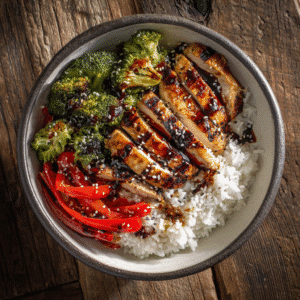
Teriyaki Chicken and Vegetable Bowls
Ingredients
- 2 boneless skinless chicken breasts or thighs
- 1 tablespoon avocado oil or olive oil
- Pinch of sea salt and black pepper
- 1 cup broccoli florets
- 1 red bell pepper sliced
- 1 medium carrot peeled and cut into strips
- Optional: snap peas mushrooms, zucchini
- 1 cup cooked jasmine or brown rice
- Optional toppings: sesame seeds green onions, chili flakes
- ¼ cup tamari or low-sodium soy sauce
- 2 tablespoons maple syrup or honey
- 1 tablespoon rice vinegar
- 1 teaspoon grated fresh ginger
- 1 clove garlic minced
- 1 teaspoon sesame oil
- 1 teaspoon cornstarch mixed with 1 tablespoon cold water
Instructions
- Cook the rice according to package instructions. Let sit covered for 5 minutes after cooking.
- In a small saucepan, combine tamari, maple syrup, rice vinegar, garlic, ginger, and sesame oil. Heat gently and stir in cornstarch slurry. Whisk until thickened, about 1–2 minutes.
- Cut chicken into bite-sized pieces. Heat oil in skillet, season chicken, and cook until golden and cooked through, 6–8 minutes.
- In the same skillet, add a bit more oil and stir-fry the vegetables starting with firmer ones like carrots and broccoli, then add bell peppers. Cook 4–5 minutes until just tender.
- Return chicken to the pan, pour in teriyaki sauce, toss to coat, and simmer 1 more minute.
- Assemble the bowl: layer rice, chicken, vegetables, and desired toppings. Serve warm.
Notes
Nutrition
How to Make Teriyaki Chicken and Vegetable Bowls Step by Step with Chef Tips
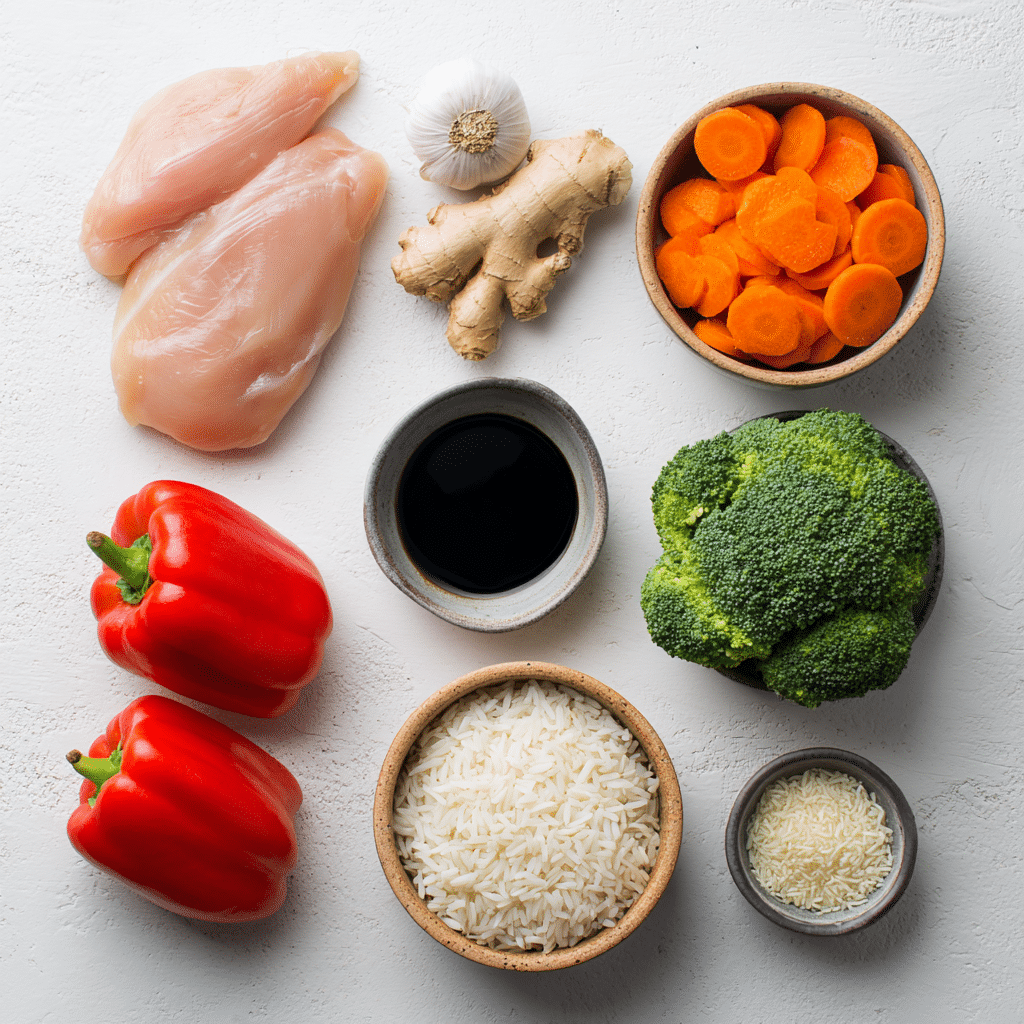
Simple ingredients, big flavor
Making Teriyaki Chicken and Vegetable Bowls at home doesn’t require special tools or hard to find ingredients. In fact, the beauty of this recipe is in its simplicity. You’ll build it in layers: a bed of warm rice, juicy chicken, crisp tender vegetables, and a homemade sauce that pulls it all together. The key is cooking each element just right and timing your sauce for the perfect glaze.
Here’s what you’ll need for 2–3 servings:
For the chicken
- 2 boneless, skinless chicken breasts (or thighs for more flavor)
- 1 tablespoon avocado oil or olive oil
- Pinch of sea salt and black pepper
For the vegetables
- 1 cup broccoli florets
- 1 red bell pepper, sliced
- 1 medium carrot, peeled and cut into thin strips
- Optional: snap peas, mushrooms, zucchini
For the teriyaki sauce
- ¼ cup tamari (for gluten free) or low sodium soy sauce
- 2 tablespoons maple syrup or honey
- 1 tablespoon rice vinegar
- 1 teaspoon grated fresh ginger
- 1 clove garlic, minced
- 1 teaspoon sesame oil
- 1 teaspoon cornstarch mixed with 1 tablespoon cold water (slurry)
For the base
- 1 cup cooked jasmine or brown rice
Optional toppings: sesame seeds, green onions, chili flakes
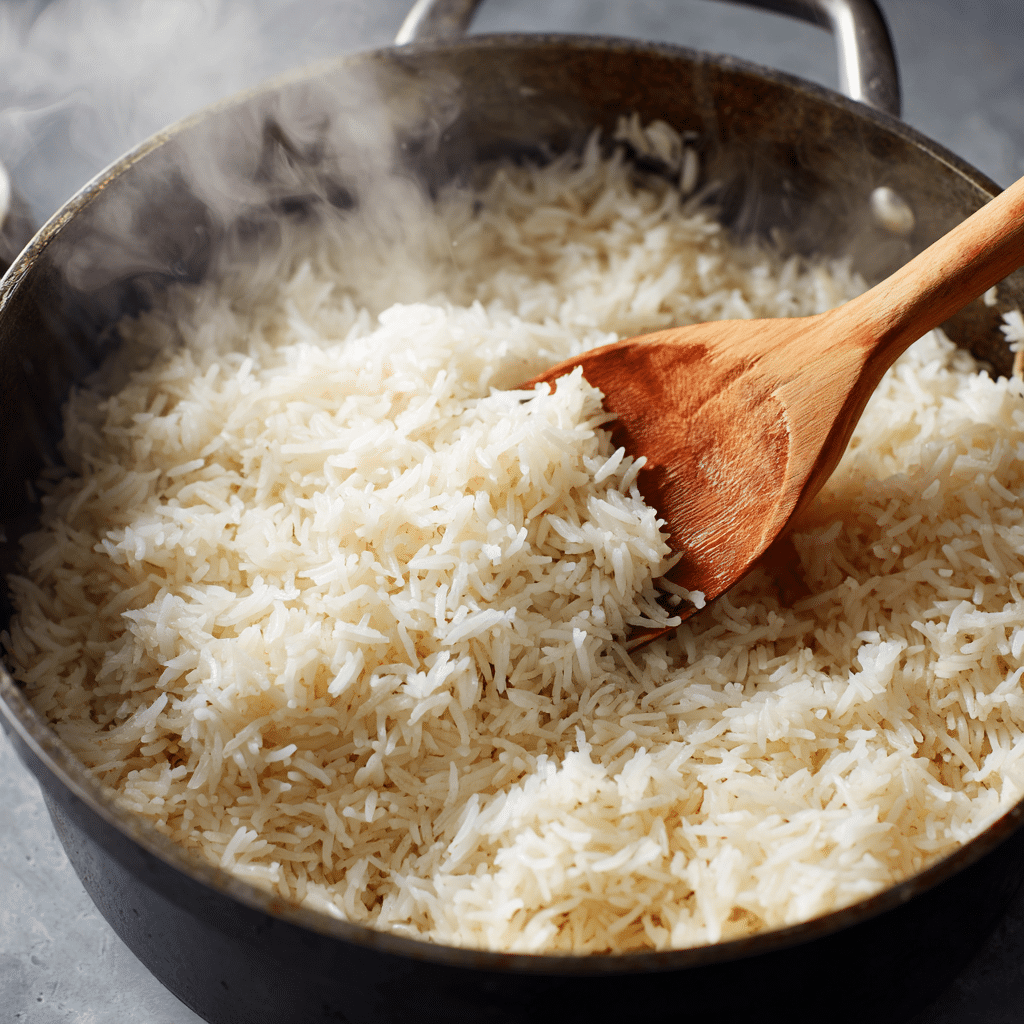
Step by step method with chef tested tips
1. Cook the rice
Start with the rice since it takes the longest. Cook jasmine rice according to the package instructions. For extra flavor, cook it in chicken broth or add a small knob of butter once it’s done.
Chef tip: Let the rice sit covered for 5 minutes after cooking this fluffs it up and prevents sogginess in your bowl.
2. Prepare the teriyaki sauce
In a small saucepan, combine tamari, maple syrup, rice vinegar, garlic, ginger, and sesame oil. Heat gently over medium low. Once it starts to simmer, stir in the cornstarch slurry and whisk until the sauce thickens slightly, about 1–2 minutes.
Chef tip: Don’t walk away. The sauce can go from perfect to too thick very quickly. Stir constantly and remove from heat once it’s glossy.
3. Sauté the chicken
Cut the chicken into bite sized pieces. Heat oil in a skillet over medium heat, season the chicken lightly, and cook until golden brown on all sides and fully cooked through about 6–8 minutes total.
Chef tip: Want that restaurant style sear? Don’t overcrowd the pan. Cook in batches if needed.
4. Stir fry the vegetables
In the same skillet, add a touch more oil and cook your vegetables. Start with firmer ones like carrots and broccoli, then add quicker cooking veggies like bell peppers. Stir fry for 4–5 minutes until just tender.
Chef tip: Keep the veggies bright and slightly crisp for contrast overcooked vegetables will dull the flavor and texture.
5. Glaze the chicken
Return the cooked chicken to the pan and pour the teriyaki sauce over it. Toss to coat and let it simmer for another minute so the sauce clings to every piece.
6. Assemble your bowl
Spoon warm rice into a bowl. Top with glazed chicken, stir-fried vegetables, and finish with sesame seeds or scallions. Serve immediately.
This method creates a bowl that’s restaurant worthy in taste and nutrition but made entirely at home, in under 30 minutes. Best of all, you can adjust it easily to fit your diet, mood, or leftovers in the fridge.
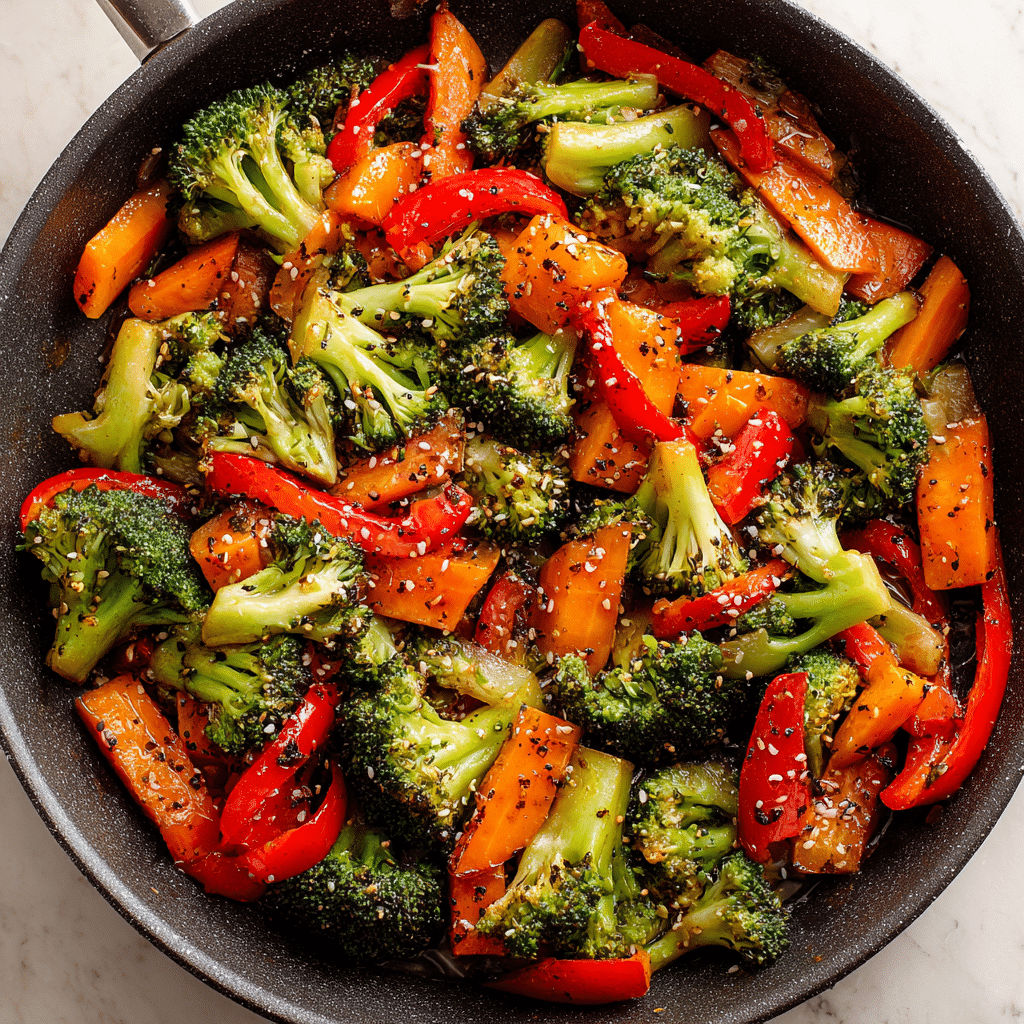
Who Are Teriyaki Chicken and Vegetable Bowls For?
A smart choice for health conscious eaters
Teriyaki Chicken and Vegetable Bowls aren’t just delicious they’re naturally balanced, making them ideal for anyone looking to eat well without giving up on flavor. With lean protein, fiber rich vegetables, and wholesome carbs, this bowl checks all the boxes for a satisfying and nutritious meal.
For people managing their weight or following a high protein diet, the chicken and vegetables provide excellent satiety. If you’re gluten intolerant like I am, using tamari keeps the dish safe without losing that classic teriyaki taste. Even athletes and active individuals love it for post-workout fuel it’s quick to digest, replenishes energy, and delivers key nutrients like potassium, iron, and B vitamins.
Because the ingredients are fresh and minimally processed, you’re avoiding added sugars and preservatives often found in takeout versions. And by making your own sauce, you’re in control of both the flavor and the sodium content.
Whether you’re eating clean, going gluten-free, or just want a colorful plate that actually fills you up, this bowl is a solid go to.
Perfect for families, meal prep, and busy lives
One reason Teriyaki Chicken and Vegetable Bowls have earned a permanent spot in my weekly routine? They’re incredibly practical. This dish fits every schedule and skill level. Even beginner cooks can nail the steps, and cleanup is a breeze especially if you use one pan.
For busy families, this recipe is a lifesaver. It’s kid friendly, easy to customize, and quick to serve. My clients with picky eaters often build the bowls buffet style: chicken in one bowl, veggies in another, rice on the side, and everyone assembles their own. It’s interactive, fun, and keeps dinner drama to a minimum.
Meal preppers love this bowl because it holds up beautifully in the fridge. Just store the chicken and vegetables separately from the rice, and reheat with a splash of water or sauce. It tastes just as fresh on day three as it did right after cooking.
Here’s who this bowl works especially well for:
- Families with different dietary needs
- Athletes needing balanced meals on the go
- Office workers looking for healthy lunch prep
- Gluten free eaters craving something filling and flavorful
- Anyone wanting to avoid the cost and calories of takeout
These bowls aren’t just convenient they empower you to eat real food that tastes amazing. That’s something I’m passionate about sharing, because I know firsthand how tough it is to find meals that are both healthy and exciting.
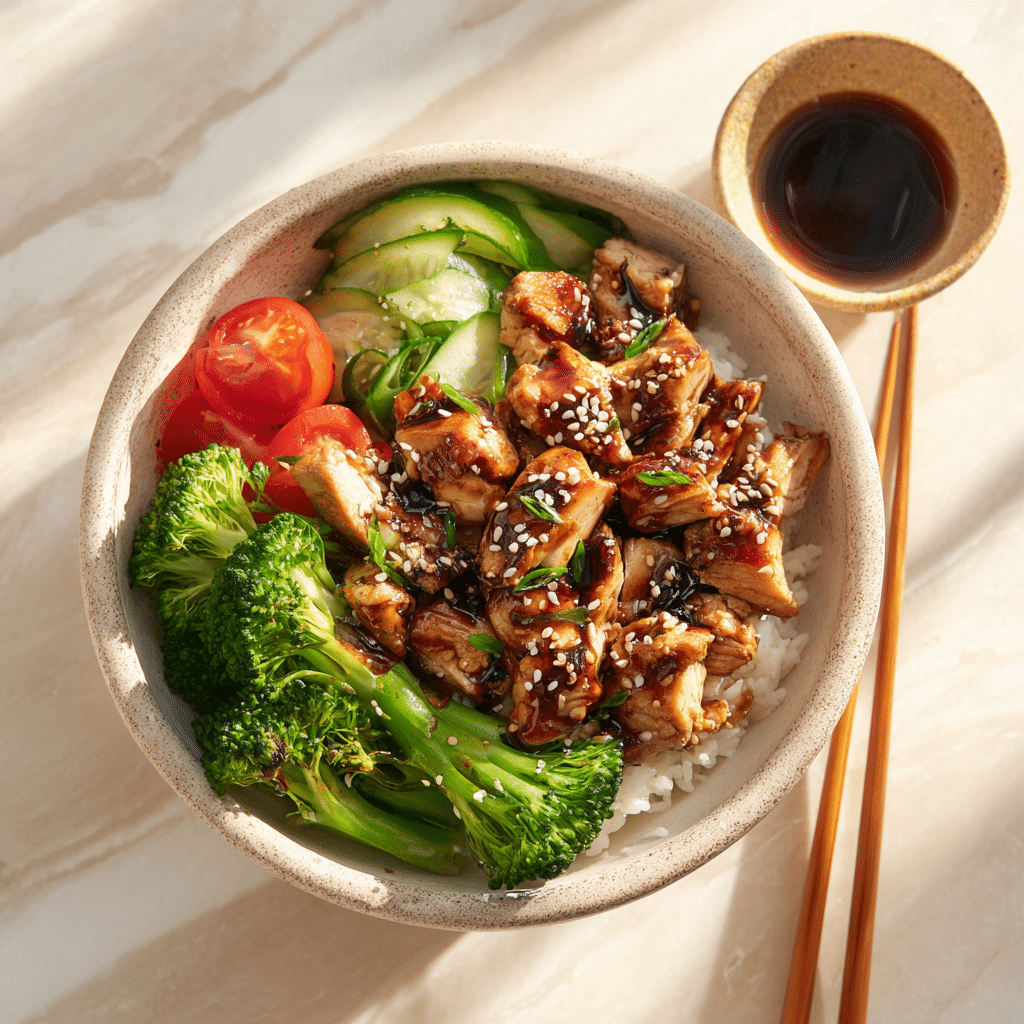
How Teriyaki Chicken and Vegetable Bowls Work
The science of satisfaction in one bowl
What makes this dish so satisfying isn’t just its flavor it’s how every part works together. The balance of sweet and savory in the glaze, combined with the crunch of fresh vegetables, tender bites of chicken, and warm rice, creates a meal that feels complete and comforting.
The sauce delivers rich umami flavor with a hint of sweetness. The protein adds substance, and the vegetables bring brightness and texture. Layered over rice, these elements form a contrast that keeps each bite interesting.
This balance isn’t random it follows classic culinary principles. In both Japanese and Mediterranean traditions, meals are crafted with awareness of texture, temperature, and variety. That’s why Teriyaki Chicken and Vegetable Bowls feel both nourishing and flavorful. They’re grounded in timeless cooking logic.
Beyond taste, this bowl supports the body: protein for energy, fiber for digestion, and healthy carbs for stamina. It’s a dish that works for both your appetite and your wellness goals.
Built to adapt, built to nourish
Part of what makes Teriyaki Chicken and Vegetable Bowls so effective is their adaptability. Whether you’re gluten free, vegetarian, or just short on time, this recipe can flex with your needs. Use tamari to keep it wheat-free, tofu to make it plant-based, or swap rice for cauliflower to reduce carbs.
It’s also meal prep friendly and family approved. Store components separately, reheat as needed, and enjoy a fresh tasting bowl every time. Even the sauce is customizable adjust sweetness, heat, or citrus depending on your mood.
For me, this was one of the first meals I reworked when I cut out gluten. It reminded me that real food could still be comforting, deeply flavored, and easy to enjoy no compromises needed.
Conclusion
Teriyaki Chicken and Vegetable Bowls prove that nourishing meals don’t have to be complicated or boring. With a simple set of ingredients and an easy to follow process, this dish offers flexibility, balance, and serious flavor. Whether you’re gluten free, meal prepping, or just looking for a healthy dinner idea that works every time, this recipe delivers. It’s personal to me not just because I adapted it after giving up gluten, but because it reminds me that good food can heal, connect, and satisfy. Try it once, and you’ll come back to it all year long.
Is teriyaki chicken bowl healthy?
Yes. A well balanced bowl typically includes lean chicken, colorful vegetables, and rice or grains all of which offer essential nutrients. When you make your own sauce with tamari and natural sweeteners, you reduce added sugar and sodium. That’s why Teriyaki Chicken and Vegetable Bowls are a popular choice for people focused on healthy eating without giving up flavor.
Which vegetables go with teriyaki chicken?
Great options include broccoli, carrots, bell peppers, and snap peas. These vegetables stir-fry quickly and hold their texture. You can also add mushrooms, zucchini, or bok choy. The goal is variety choose a colorful mix to keep your teriyaki chicken and vegetable bowls exciting and satisfying.
What mixes well with teriyaki?
Garlic, ginger, sesame oil, pineapple, and lime all pair beautifully with teriyaki. You can enhance the sauce by adding chili flakes, sriracha, or a splash of orange juice. It’s a flexible flavor base that works across proteins and vegetables.
Is teriyaki healthy to eat every day?
It depends on how it’s prepared. Store-bought versions can be high in sugar and sodium, but homemade teriyaki made with whole ingredients is a clean, flavorful option. Eating it daily is fine if you rotate your vegetables, grains, and proteins to keep things balanced.

